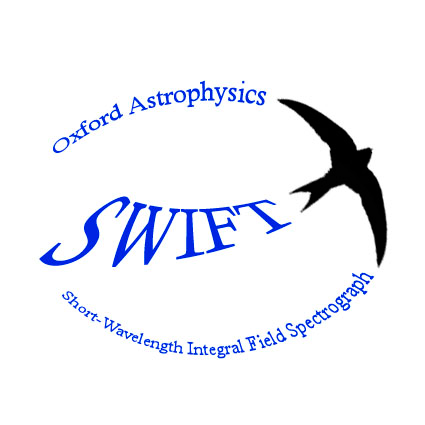|
|
SWIFT Key Science Programs
A few key science pograms have been planned with SWIFT since its early days. A brief summary of some of them is included below. This is by no means an exhaustive list of the types of science that can be done with SWIFT, indeed there are number of other programs that are being actively pursued by researchers at Oxford and Caltech.
- Exploring the evolution of the Tully-Fisher relation out to z∼1.7: There is evidence from a large slit spectroscopic survey of 30,000 galaxies (the DEEP2 survey) that the kinematics of disk-like galaxies change over ∼0.1<z<∼1.5. As one looks back in time, there is an
increasing fraction of higher mass galaxies with disordered motions. However, the nature of these
kinematically peculiar objects is unknown since our spectroscopy cannot probe the full velocity
structure of the galaxies. We may be witnessing an early stage of disk formation as gas dissipates
and settles into coplanar rotating orbits, but cannot tell without the high spatial resolution
kinematics that SWIFT can provide for z∼1.5 (I-band) targets. We plan to measure the [OII] velocity and
dispersion fields of 12 kinematically selected galaxies. One thing we will investigate is whether the irregular kinematics detected in the DEEP
slit spectra are driven by phenomena such as rotation, major or minor-merger activity, and/or
violent star-formation processes. (extract from proposal by S. Kassin, L. Fogarty et al.)
- Kinematics of Lyman α emission at 5 ≤ z ≤ 7: The highest redshift galaxies (that are not QSOs) have been mostly detected through their Lyman α emission. At 6≤z≤7, close to the epoch of re-ionization, large numbers of Lyman α emitters have been discovered through wide field, narrow band surveys. A small number of these sources exhibit extended Lyman α emission, although the source of the extended emission is unclear. Three mechanisms have been proposed – (1) cooling radiation from gravitationally heated primordial gas infalling into a dark halo potential (Haiman et al. 2000; Fardal et al. 2001; Furlanetto
et al. 2005; Dekel & Birnboim 2006; Dijkstra et al. 2006a, 2006b), (2) resonant scattering of Ly
α photons from the central (hidden) ionizing source (Møller & Warren 1998; Haiman & Rees
2001; Weidinger et al. 2004, 2005; Laursen & Sommer-Larsen 2007), and (3) starburst-driven
galactic winds (Taniguchi & Shioya 2000; Ohyama et al. 2003; Geach et al. 2005).
At present, it is not clear which mechanism operates in most sources, especially at the highest
redshifts, where few studies have been carried out. By mapping the morphology and kinematics of the Ly α
emission, we will be able to gain some knowledge of the likely mechanism responsible for the Ly α
light, whether infall or super-winds, although interpretation of the Ly α kinematics is necessarily
complex, as it is a resonance line. SWIFT is particularly well suited for these studies as it combines integral field spectroscopy with very high sensitivity at red wavelengths.(extract from proposal by N. Thatte et al.)
- Weighing super massive black holes in nearby galaxies using the Ca triplet: The goal of this science program is to carry out a census of the masses of central dark objects in nearby galaxy nuclei. This very active field of research has mostly relied on measurements using spectrographs on the Hubble Space Telescope, and more recently, using AO assisted integral field spectrographs in the near infrared at ground based telescopes. SWIFT, working with PALM3K, provides an unique combination of sensitivity (through use of the Ca triplet feature, which, at ∼8500 Angstroms, has much lower sky background than at near-infrared wavelengths) and spatial resolution (with PALM3K, at ∼8500 Angstroms, the PSF FWHM would be well below 0.1″). This would enable observations of lower mass spiral galaxy bulges and giant ellipticals with flat cores, as well as allowing a larger sample to be studied.
|

